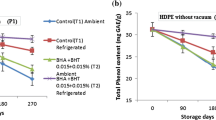Abstract
Brazilian peanut oil content increased with oven heating (65.08%) and decreased with microwave heating process (61.00%). While the phenolic content of untreated Brazilian nut was the highest of 68.97 mg GAE/100 g. Hazelnut (Sivri) contained the highest antioxidant activity (86.52%, untreated). Results reflected significantly differences between the antioxidant effect and total phenol contents of Brazilian nut and hazelnut (Sivri) kernels heated in the oven and microwave. Microwave heating caused a decrease in antioxidant activity of hazelnut. Gallic acid, 3,4-dihydroxybenzoic acid and (+)- and catechin were the main phenolic compounds of raw Brazilian nut with the value of 5.33, 4.33 and 4.88 mg/100 g, respectively, while the dominant phenolics of raw hazelnut (Sivri) kernels were gallic acid (4.81 mg/100 g), 3,4-dihydroxybenzoic acid (4.61 mg/100 g), (+)-catechin (6.96 mg/100 g) and 1,2-dihydroxybenzene (4.14 mg/100 g). Both conventional and microwave heating caused minor reduction in phenolic compounds. The main fatty acids of Brazilian nut oil were linoleic (44.39–48.18%), oleic (27.74–31.74%), palmitic (13.09–13.70%) and stearic (8.20–8.91%) acids, while the dominant fatty acids of hazelnut (Sivri) oil were oleic acid (80.84%), respectively. The heating process caused noticeable change in fatty acid compositions of both nut oils.
Similar content being viewed by others
References
Alasalvar C, Pelvan E, Amarowicz R (2010) Effects of roasting on taste-active compounds of Turkish hazelnut varieties (Corylus avellana L.). J Agric Food Chem 58(15):8674–8679
AOAC (1990) Official methods of analysis, 15th edn. Association of Official Analytical Chemists, Washington
Ciarmiello LF, Piccirillo P, Gerardi C, Piro F, De Luca A, D’Imperio F, Rosito V, Poltronieri P, Santino A (2013) Microwave irradiation for dry-roasting of hazelnuts and evaluation of microwave treatment on hazelnuts peeling and fatty acid oxidation. J Food Res 2:22–35
Costa PA, Balles CA, Teixeirra-Filho Godoy HT (2010) Phytosterol and tocopherol content of pulps and nuts of Brazilian fruits. Food Res Int 43:1603–1606
Cristofori V, Ferramondo S, Bartazza G, Bigmani C (2008) Nut and kernel traits and chemical composition of hazelnut (Corylus avellana L.) cultivars. J Sci Food Agric 88:1091–1098
Decareau RV (1992) Microwave foods: new product development. Food and Nutrition Press, Trumbull
Derewiaka D, Szwed E, Wolosiak R (2014) Physicochemical properties and composition of lipid fraction of selected edible nuts. Pak J Bot 46:337–343
ISO-International Organization for Standardization (1978) Animal and vegetable fats and oils preparation of methyl esters of fatty acids, ISO. Geneva, Method ISO 5509, pp 1–6
Jakopic J, Mikulic Petkovsek M, Likozar A, Solar A, Stampar F, Veberic R (2011) HPLC-MS identification of phenols in hazelnut (Corylus avellana L.) kernels. Food Chem 124:1100–1106
Kim IH, Kim CJ, You JM, Lee KW, Kim CT, Chung SH, Tae BS (2002) Effect of roasting temperature and time on the chemical composition of rice germ oil. J Am Oil Chem Soc 79:413–418
Lee SK, Mbwambo ZH, Chung HS, Luyengi L, Games EJC, Mehta RG (1998) Evaluation of the antioxidant potential of natural products. Comb Chem High Throughput Screen 1:35–46
Megahed MG (2001) Microwave roasting of peanuts: effects on oil characteristics and composition. Nahrung/Food 4:255–257
Mudgett RE (1989) Microwave food processing. Food Technol 43:117
Muller CH (1981) Castanha-do-Brasil: Estudos agronômicos. EMBRAPA, CPATU, Belém
Püskülcü H, İkiz F (1989) Introduction to statistic. Bilgehan Press, Bornova, p 333
Rosenberg U, Bogl W (1987) Microwave thawing, drying and baking in the food industry. Food Technol 41:85–91
Schlegel W (1992) Commercial pasteurization and sterilization of foods products using microwave technology. Food Technol 46:62–63
Silva AC, Sarturi HJ, Dall’Oglio EL, Soares MA, Sousa PT, Vasconcelos LG, Kuhnen CA (2016) Microwave drying and disinfestation of Brazil nut seeds. Food Control 70:119–129
Solar A, Stampar F (2011) Characterisation of selected hazelnut cultivars: phenology, growing and yielding capacity, market quality and nutraceutical value. J Sci Food Agric 91(7):1205–1212
Yoo KM, Lee KW, Park JB, Lee HJ, Hwang IK (2004) Variation in major antioxidants and total antioxidant activity of Yuzu (Citrus junos Sieb ex Tanaka) during maturation and between cultivars. J Agric Food Chem 52:5907–5913
Yoshida H, Kajimoto G (1994) Microwave heating affects composition and oxidation stability of sesame (Sesamum indicum) oil. J Food Sci 59:613–625
Acknowledgements
The authors extend their appreciation to the International Scientific Partnership Program ISPP at King Saud University for funding this research work through ISPP# 0015.
Author information
Authors and Affiliations
Corresponding author
Rights and permissions
About this article
Cite this article
Özcan, M.M., Juhaimi, F.A. & Uslu, N. The effect of heat treatment on phenolic compounds and fatty acid composition of Brazilian nut and hazelnut. J Food Sci Technol 55, 376–380 (2018). https://doi.org/10.1007/s13197-017-2947-3
Revised:
Accepted:
Published:
Issue Date:
DOI: https://doi.org/10.1007/s13197-017-2947-3




